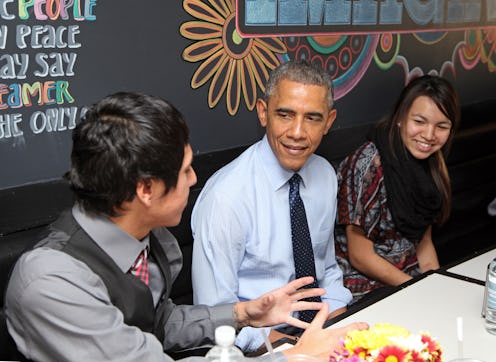News
Obama Just Became The Third President To Do This

On Friday afternoon, President Barack Obama became just the third president of the United States to visit an Indian reservation — and the first to do so in nearly 80 years. Obama visited the tiny Native American community of Cannon Ball, North Dakota, part of the Standing Rock Sioux Tribal Nation — announcing: "Every American, including every Native American, deserves the chance to work hard and get ahead." During his visit, Obama introduced a new economic and educational initiative for Native Americans, a group historically mistreated and ignored by the federal government.
Cannon Ball is a representative microcosm of the issues that plague the Native nation at large. Poverty is overwhelmingly present, with 40 percent of residents at or below the poverty line. Two-thirds of them are unemployed, and at least 50 percent of students never finish high school. Sexual violence, alcoholism, and suicide rates are disproportionately high on reservations. On some reservations, youth suicides happen 10 times more frequently than they do in the rest of the nation. And despite continuing health, educational, and economic concerns, many administrations turned a blind eye to the plight of the first Americans.
According to several tribal leaders, however, that changed with the Obama administration.
What Obama's Done For The Native Population
Though Obama has never visited a reservation in his six years as president, many leaders agree that his physical absence is easily forgiven considering the major strides he has made on behalf of the Native population. Dave Archambault II, chairman of Standing Rock, went as far as to tell the Washington Post, “The best thing that’s happened to Indian Country has been President Obama being elected."
Obama has been a longtime proponent of advancing Native causes. Before being elected in 2008, Obama paid another visit to Indian country, and announced that he planned to improve health care and education on reservations. He was accepted by the Crow into the Black Eagle Family, and given the name, “One Who Helps People Throughout the Land.”
And Obama has certainly lived up to his title. Whereas previous administrations rarely received Native leaders in Washington, Obama established an annual Tribal Nations Conference at the White House, allowing Natives, quite literally, to have a seat at the table when discussing policies that directly impact their people. Moreover, Obama has exercised his executive powers to jumpstart such programs as the White House Initiative on American Indian and Alaska Native Education, and similarly novel initiatives meant to provide assistance to a too-long underrepresented people.
Obama has also greatly simplified the process for Natives to secure disaster relief, allowing them to directly contact FEMA rather than first submitting a request to the state's governor. After decades of arguing over a class-action lawsuit against the federal government for mismanaging native land-trust royalties, the Obama administration has agreed to settle for $3.4 billion. Unfortunately, this payback process has become mired in bureaucratic secrecy and appeals.
In terms of sexual violence, Obama reauthorized the Violence Against Women Act in 2013, which incredibly, for the first time, allowed "tribal criminal justice systems to prosecute non-Indians who sexually assault American Indian women." This was a huge step as the Department of Justice reported that non-Natives committed 86 percent of reported sexual assaults.
The Affordable Care Act, perhaps the single most important piece of legislation passed under the Obama administration, "permanently reauthorized the Indian Healthcare Improvement Act," making healthcare more accessible and more high quality than before. Obama has also publicly come out in support of changing the Redskins team name.
What He Told The Audience
And while Obama was warmly received — along with his plans of bringing high-speed Internet to tribal schools, implementing better training for teachers, and fostering small-business initiatives — there were more issues that Natives hope to see addressed. Chief among these is the Keystone XL pipeline, which is greatly opposed by both environmental activists and tribal leaders. The pipeline has been described as a "black snake" that will deplete Native water sources and further destroy their environment.
Obama told his audience that the government would work to help break the cycle of poverty and joblessness characteristic of the Native nation. But while Obama has made tremendous strides towards progress amongst Native nations, his presidency is drawing to a close, and it will be up to the next administration to continue his hard work on behalf of the Indian population in the U.S. If the GOP comes into power, it seems unlikely that Native issues will be at their minds' forefront — at the very least, Keystone XL will be signed into action.
But for the next two years, President Obama has the capacity to further the situation of Natives across the country, and his visit serves as a testament to his commitment.